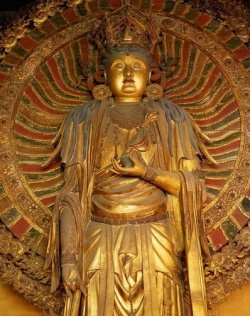Universal Kindness
Samantabhadra (Universal Kindness) is regarded as Adi-Buddha and as first Dhyani - Bodhisattva
Among the ancient Northern Buddhist sects and the unreformed Lamaist sects in Tibet, SAMANTABHADRA was looked upon as Highest Intelligence, a primordial Buddha, or Adi-Buddha. He is figured seated with the legs locked; but unlike the other representations of Adi-Buddha, he has neither crown nor ornaments, and in his esoteric form was represented nude in blue color embracing his Sakti [consort] in white color.
An Adi-Buddha infinite, omniscient, self-existing, without beginning and without end, the source and originator of all things, who by virtue of five sorts of wisdom [jnana] and by the exercise of five meditations [dhyana] evolved five Dhyani Buddhas. When this Adi-Buddha is represented with his female energy, he is called Yogambara and the sakti Digambara [Jnanesvari].
Samantabhadra Tib.: "Kun tu bzang po"
Tibetan Buddhists believe that the Adi-Buddha, the primordial and highest being, created the Dhyani Buddhas by his meditative powers.
The Five Dhyani Buddhas are celestial Buddhas visualized during meditation. The word Dhyani is derived from the Sanskrit dhyana, meaning "meditation." The Dhyani Buddhas are also called Jinas ("Victors" or "Conquerors") and are considered to be great healers of the mind and soul. They are not historical figures, like Gautama Buddha, but transcendent beings who symbolize universal divine principles or forces. They represent various aspects of the enlightened consciousness and are guides to spiritual transformation.
Each Dhyani Buddha is associated with certain attributes and symbols. Each one embodies one of the five wisdoms, which antidote the five deadly poisons that are of ultimate danger to man's spiritual progress and keep him tied to worldly existence. Buddhists teach that the Dhyani Buddhas are able transmute the five poisons into their transcendent wisdoms. The Tibetan Book of the Dead recommends that the devote meditate on the Dhyani Buddhas so that their wisdoms will replace the negative forces he has allowed to take hold within.
Each Buddha rules over one of the directions of space al one of the cosmic realms of ether, water, earth, fire and air. The Dhyani Buddhas also personify the five skandhas, components that make up cosmic existence as well as human personality. These components are consciousness, form, feeling, perception and volition.
